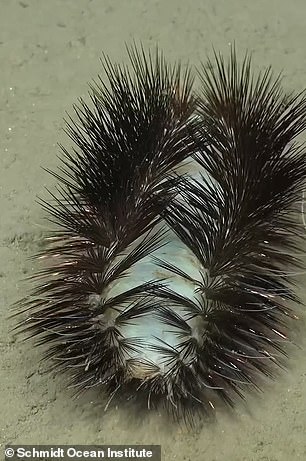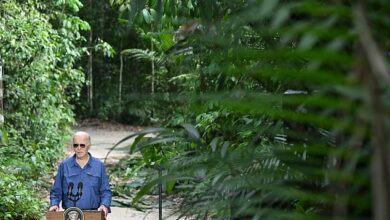Underwater robot discovers a never-before-seen creature at the intersection of three tectonic plates in the Pacific Ocean – as baffled viewers call it the ‘forbidden toilet scrubber’

At first glance, you’d be forgiven for mistaking it for a sparkly pair of fake eyelashes.
But the creature is very real and was discovered at the intersection of three tectonic plates in the Pacific Ocean.
Researchers from the Schmidt Ocean Institute spotted the animal using an underwater robot to scour the seabed.
The animal is a polychaete – a class of marine worms, commonly known as bristle worms.
‘To describe this polychaete you simply have to use jazz hands – it’s the only way to capture the dazzle of this deep-sea worm!’ the experts said in an Instagram post about the polychaete.
Images of the creature have generated huge interest on Instagram, with thousands of viewers flocking to the comments to talk about it.
One viewer described it as a ‘forbidden toilet scrubber’, while another called it a ‘deep sea Christmas tree’.
And someone joked: ‘It looks like two eyelashes together.’


At first glance, you’d be forgiven for mistaking it for a sparkly pair of fake eyelashes. But the creature is very real and was discovered at the intersection of three tectonic plates in the Pacific Ocean

One viewer described it as a ‘forbidden toilet scrubber’, while another called it a ‘deep sea Christmas tree’
The polychaete was spotted while ROV (remotely operated vehicle) pilots were scouting the Chilean fringe.
“The international scientific team is exploring a coastal deep-sea area along the edge where a submerged continental shelf extends from the west coast of the country and dips steeply and suddenly into the Pacific Ocean,” the Schmidt Ocean Institute explained on Instagram.
‘It runs the length of South America due to the subduction of the Pacific plate beneath the South American plate.
‘The confluence of tectonic forces and terrestrial influences makes this margin a natural laboratory for investigating chemosynthetic and deep-sea environments where these types of animals occur. [queue jazz hands] glittering deep sea worm.’
In a video posted to the Schmidt Ocean Institute’s Instagram account, the animal is seen prowling along the seafloor, its iridescent bristles glistening in the light.
Polychaete means “many bristles,” the experts explained.
“Each body segment has a pair of fleshy projections called parapodia, covered with bristles called chaetae,” they wrote.
‘Some worms are luminous, but this cheeky starlet has protein structures in its bristles that make them iridescent.

In a video posted to the Schmidt Ocean Institute’s Instagram account, the animal is seen prowling along the seabed, its iridescent bristles glistening in the light
‘Polychaetes play a crucial role in our global ocean, from heat-tolerant extremophiles at hydrothermal vents to the bone-eating Osedax worms that cycle nutrients.’
Several viewers took to the comments to discuss the creature.
“I don’t know, but that’s an alien,” one user wrote.
Another added: “That’s a scrub brush for a sink.”
And someone joked: ‘Who is that Pokemon?’
The Chile margin has fallencalled a ‘natural laboratory’, and has an average water depth of approximately 2,652 to 3,281 feet.
During a 55-day expedition ending December 5, researchers set out to map, sample and characterize deep-sea exosystems along Chile’s central-southern border.
“Their research will advance our understanding of a vital area of the ocean while strengthening efforts to manage and protect Chilean waters,” the Schmidt Ocean Institute explains on its website.




